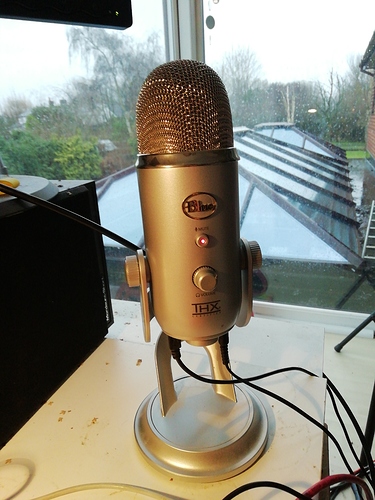The latest USB connected device…
A blue yeti USB microphone (with headphone output)
Standard USB device but hw:1 and alteration to /etc/dbus-1/system-local.conf
I get audio in the phones from the zynth… Not so sure about input yet …
-P 70 -t 2000 -s -d alsa -d hw:1 -r 48000 -p 256 -n 2 -X raw
root@zynthian-nord:~# amixer
amixer: Mixer attach default error: No such file or directory
root@zynthian-nord:~# aplay -l
**** List of PLAYBACK Hardware Devices ****
card 1: Microphone [Yeti Stereo Microphone], device 0: USB Audio [USB Audio]
Subdevices: 0/1
Subdevice #0: subdevice #0
root@zynthian-nord:~#
Just for my benefit…
-P, --realtime-priority int
When running --realtime, set the scheduler priority to int.-t, --timeout int
Set client timeout limit in milliseconds. The default is 500 msec. In realtime mode the client timeout must be smaller than the watchdog timeout (5000 msec).-s, --softmode
Ignore xruns reported by the ALSA driver. This makes JACK less likely to disconnect unresponsive ports when running without --realtime.-d, --device name
The ALSA pcm device name to use. If none is specified, JACK will use "hw:0", the first hardware card defined in /etc/modules.conf.-r, --rate int
Specify the sample rate. The default is 48000.
(not to be confused with --no-realtime (…?)-p, --port-max n
Set the maximum number of ports the JACK
server can manage. The default value is 256.-n, --nperiods int
Specify the number of periods of playback latency. In seconds, this corresponds to --nperiods times --period divided by --rate. The default is 2, the minimum allowable. For most devices,there is no need for any other value with the --realtime option. Without realtime privileges or with boards providing unreliable interrupts (like ymfpci), a larger value may yield fewer xruns. This can also help if the system is not tuned for reliable realtime scheduling. For most ALSA devices, the hardware buffer has exactly --period times --nperiods frames. Some devices demand a larger buffer. If so, JACK will use the smallest possible buffer containing at least --nperiods, but the playback latency does not increase. For USB audio devices it is recommended to use -n 3. Firewire devices supported by FFADO are configured with -n 3 by default.-X, --midi [seq|raw]
Specify which ALSA MIDI system to provide access to. Using raw will provide a set of JACK MIDI ports that correspond to each raw ALSA device on the machine. Using seq will provide a set of JACK MIDI ports that correspond to each ALSA "sequencer" client (which includes each hardware MIDI port on the machine). raw provides slightly better performance but does not permit JACK MIDI communication with software written to use the ALSA "sequencer" API.
